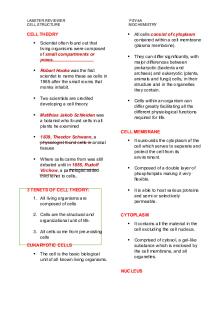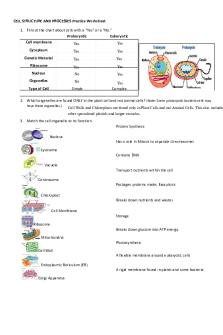Cell Structure worksheet PDF

| Title | Cell Structure worksheet |
|---|---|
| Author | govi Uchiha |
| Course | Anthropology and Human Origins |
| Institution | Indian River State College |
| Pages | 3 |
| File Size | 62.9 KB |
| File Type | |
| Total Downloads | 87 |
| Total Views | 135 |
Summary
Download Cell Structure worksheet PDF
Description
Cell Structure & Function Worksheet Write true if the statement is true or false if the statement is false. _____ 1. All organisms are made of more than one cell. _____ 2. Early microscopes created by Leeuwenhoek were almost as strong as modern light microscopes. _____ 3. Proteins are made on ribosomes. _____ 4. Prokaryotic cells have a nucleus. _____ 5. The plasma membrane forms the physical boundary between the cell and its environment. _____ 6. For cells, a smaller size is more efficient. _____ 7. Organelles are located within the cytoplasm. _____ 10. DNA is located in the nucleus of prokaryotic cells. _____ 11. The water-hating hydrophobic tails of the phospholipid bilayer face the outside of the cell membrane. _____ 12. The cytoplasm essentially acts as a “skeleton” inside the cell. _____ 13. Centrioles help organize chromosomes before cell division. _____ 14. Ribosomes can be found attached to the endoplasmic reticulum. _____ 15. ATP is made in the mitochondria. _____ 16. Small hydrophobic molecules can easily pass through the plasma membrane. _____ 17. In cell-level organization, different cells are specialized for different functions. _____ 18. The flagella on your lung cells sweep foreign particles and mucus toward the mouth and nose. _____ 19. Mitochondria contains its own DNA. _____ 20. The plasma membrane is a single phospholipid layer that supports and protects a cell and controls what enters and leaves it. _____ 21. The cytoskeleton is made from thread-like filaments and tubules.
Match the vocabulary word with the proper definition. Definitions _____ 1. the arrangement of phospholipids in the plasma membrane _____ 2. helps make and transport proteins and lipids _____ 3. stores and transports protein and lipid molecules _____ 4. helps the cell maintain its shape and holds cell organelles in place within the cytoplasm _____ 5. help organize the chromosomes before cell division _____ 6. organelle that processes proteins and prepares them for use both inside and outside the cell _____ 7. larger of the sac-like organelles that store and transport materials in the cell _____ 8. describes the formation of eukaryotic cells _____ 9. energy-carrying molecule _____ 10. “power plant” of the cell Terms a. ATP b. centriole c. cytoskeleton d. endoplasmic reticulum e. endosymbiotic theory
f. Golgi apparatus g. mitochondria h. phospholipid bilayer i. vacuole j. vesicle
Critical Thinking Read these passages from the text and answer the questions that follow.
Passive Transport Passive transport occurs when substances cross the plasma membrane without any input of energy from the cell. No energy is needed because the substances are moving from an area where they have a higher concentration to an area where they have a lower concentration. Concentration refers to the number of particles of a substance per unit of volume. The more particles of a substance in a given volume, the higher the concentration. A substance always moves from an area where it is more concentrated to an area where it is less concentrated. It’s a little like a ball rolling down a hill. It goes by itself without any input of extra energy.
Simple Diffusion Diffusion is the movement of a substance across a membrane, due to a difference in concentration, without any help from other molecules. The substance simply moves from the side of the membrane where it is more concentrated to the side where it is less concentrated. Substances that can squeeze between the lipid molecules in the plasma membrane by simple diffusion are generally very small, hydrophobic molecules, such as molecules of oxygen and carbon dioxide.
Osmosis Osmosis is a special type of diffusion — the diffusion of water molecules across a membrane. Like other molecules, water moves from an area of higher concentration to an area of lower concentration. Water moves in or out of a cell until its concentration is the same on both sides of the plasma membrane.
Facilitated Diffusion Water and many other substances cannot simply diffuse across a membrane. Hydrophilic molecules, charged ions, and relatively large molecules, such as glucose, all need help with diffusion. The help comes from special proteins in the membrane known as transport proteins. Diffusion with the help of transport proteins is called facilitated diffusion. There are several types of transport proteins, including channel proteins and carrier proteins. • Channel proteins form pores, or tiny holes, in the membrane. This allows water molecules and small ions to pass through the membrane without coming into contact with the hydrophobic tails of the lipid molecules in the interior of the membrane. • Carrier proteins bind with specific ions or molecules, and in doing so, they change shape. As carrier proteins change shape, they carry the ions or molecules across the membrane.
Questions 1. Explain why passive transport does not require energy.
2. What is a main difference between diffusion and facilitated diffusion?
3. Describe how simple diffusion proceeds. What kind of molecules can move across the membrane by simple diffusion?
4. How is water transported across the membrane?
5. What are the two types of transport proteins? Describe how they function...
Similar Free PDFs

Cell Structure Worksheet
- 1 Pages

Cell Structure worksheet
- 3 Pages

1.b Cell Structure Worksheet
- 1 Pages

Cell Structure SE 1
- 3 Pages

Labster 1 cell structure
- 10 Pages

Cell Structure (reviewer)
- 7 Pages

Structure of generalized cell
- 2 Pages

Cell Structure notes
- 13 Pages

Cell Structure Practice
- 3 Pages

CELL Structure OF Microorganisms
- 7 Pages

Prokaryotic Cell Structure
- 4 Pages

IB 1108 L10 Cell Structure
- 4 Pages
Popular Institutions
- Tinajero National High School - Annex
- Politeknik Caltex Riau
- Yokohama City University
- SGT University
- University of Al-Qadisiyah
- Divine Word College of Vigan
- Techniek College Rotterdam
- Universidade de Santiago
- Universiti Teknologi MARA Cawangan Johor Kampus Pasir Gudang
- Poltekkes Kemenkes Yogyakarta
- Baguio City National High School
- Colegio san marcos
- preparatoria uno
- Centro de Bachillerato Tecnológico Industrial y de Servicios No. 107
- Dalian Maritime University
- Quang Trung Secondary School
- Colegio Tecnológico en Informática
- Corporación Regional de Educación Superior
- Grupo CEDVA
- Dar Al Uloom University
- Centro de Estudios Preuniversitarios de la Universidad Nacional de Ingeniería
- 上智大学
- Aakash International School, Nuna Majara
- San Felipe Neri Catholic School
- Kang Chiao International School - New Taipei City
- Misamis Occidental National High School
- Institución Educativa Escuela Normal Juan Ladrilleros
- Kolehiyo ng Pantukan
- Batanes State College
- Instituto Continental
- Sekolah Menengah Kejuruan Kesehatan Kaltara (Tarakan)
- Colegio de La Inmaculada Concepcion - Cebu



